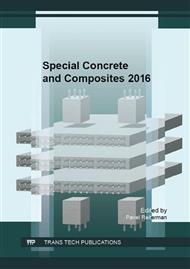[1]
P. Bamonte, P.G. Gambarova, P. Meda, Today's concretes exposed to fire – test results and sectional analysis, Structural Concrete – Journal of the FIB 9 (1) (2008) 19-29.
DOI: 10.1680/stco.2008.9.1.19
Google Scholar
[2]
I. Netinger, I. Kesegic, I. Guljas, The effect of high temperatures on the mechanical properties of concrete made with different types of aggregates, Fire Safety Journal 46 (2011) 425-430.
DOI: 10.1016/j.firesaf.2011.07.002
Google Scholar
[3]
A. Korjenic, J. Zach, J. Hroudová, The use of insulating materials based on natural fibers in combination with plant facades in building constructions, Energy and Buildings 116(15) (2016) 45-58.
DOI: 10.1016/j.enbuild.2015.12.037
Google Scholar
[4]
O. Arioz, Effects of elevated temperatures on properties of concrete, Fire Safety Journal 42 (8) (2007) 516-522.
DOI: 10.1016/j.firesaf.2007.01.003
Google Scholar
[5]
D.J. Kim et al., Comparative Flexural Behaviour of Hybrid Ultra High Performance Fiber Reinforced Concrete with Different Macro Fibers, Construction and Building Materials 25 (2011) 4144-4155.
DOI: 10.1016/j.conbuildmat.2011.04.051
Google Scholar
[6]
M. Keppert, E. Vejmelková, S. Švarcová, P. Bezdička, R. Černý, Microstructural changes and residual properties of fiber reinforced cement composites exposed to elevated temperatures, Cement Wapno Beton, 2012, Vol. 17/79, no. 2, pp.77-89.
Google Scholar
[7]
J. Brožovský, L. Bodnárová, Contribution to the issue of evaluating the compressive strength of concrete exposed to high temperatures using the Schmidt rebound hammer, Russian Journal of Nondestructive Testing 52(1) (2016) 44-52.
DOI: 10.1134/s1061830916010046
Google Scholar
[8]
K.L. Scrivener, A. Capmas, Calcium Aluminate Cements, in: Lea's chemistry of cement and concrete 4th ed. Chapter 13 (1998), pp.713-782.
DOI: 10.1016/b978-075066256-7/50025-4
Google Scholar
[9]
O. Holčapek, P. Reiterman, M. Jogl, Refractory Cement Composite Reinforced by Various Types of Fibers, Materials Science Forum 824 (2015) 173-177.
DOI: 10.4028/www.scientific.net/msf.824.173
Google Scholar
[10]
M. Jogl, P. Reiterman, O. Holčapek, P. Konvalinka, Influence of metakaolin addition on fracture properties of refractory concretes reinforced with basalt fibres, Cement Wapno Beton 21/3 (2016) 140-148.
Google Scholar
[11]
O. Holčapek, P. Reiterman, P. Konvalinka, Fracture characteristics of refractory composites containing metakaolin and ceramic fibers, Advances in Mechanical Engineering 7(3) (2015) 1-13.
DOI: 10.1177/1687814015573619
Google Scholar
[12]
S.E. Artemenko, Yu.A. Kadykova, Polymer composite materials based on carbon, basalt and glass fibres, Fiber chemistry 40 (2008) pp.37-39.
DOI: 10.1007/s10692-008-9010-0
Google Scholar
[13]
M. Bruncvik, P. Štemberk, Explosion-resistant reinforced-concrete construction kit for shelter in extreme situations, Modelling, Measurement and Control B 81(1-2) (2012) 34-49.
Google Scholar
[14]
M. Jogl, P. Reiterman, O. Holčapek, J. Koťátková, P. Konvalinka, Residual properties of fiber-reinforced refractory composites with a fireclay filler, Acta Polytechnica 56(1) (2016) 27-32.
DOI: 10.14311/app.2016.56.0027
Google Scholar
[15]
S. Haoyang, J. Xu, Dynamic Compressive Behavior of Ceramic Fiber Reinforced Concrete Under Impact Load, Construction and Building Materials 45 (2013), pp.475-488, http: /dx. doi. org/10. 1016/j. conbuildmat. 2013. 04. 008.
DOI: 10.1016/j.conbuildmat.2013.04.008
Google Scholar
[16]
G.A. Khoury, Effect of fire on concrete and concrete structures, Progress in Structural Engineering and Materials 2 (4) (2000), pp.429-447.
DOI: 10.1002/pse.51
Google Scholar
[17]
R. Boris et al., Effect of holding temperature on properties of different types of heat-resistant concrete, Refractories and Industrial Ceramics 54 (2014) 397–400.
DOI: 10.1007/s11148-014-9619-x
Google Scholar


